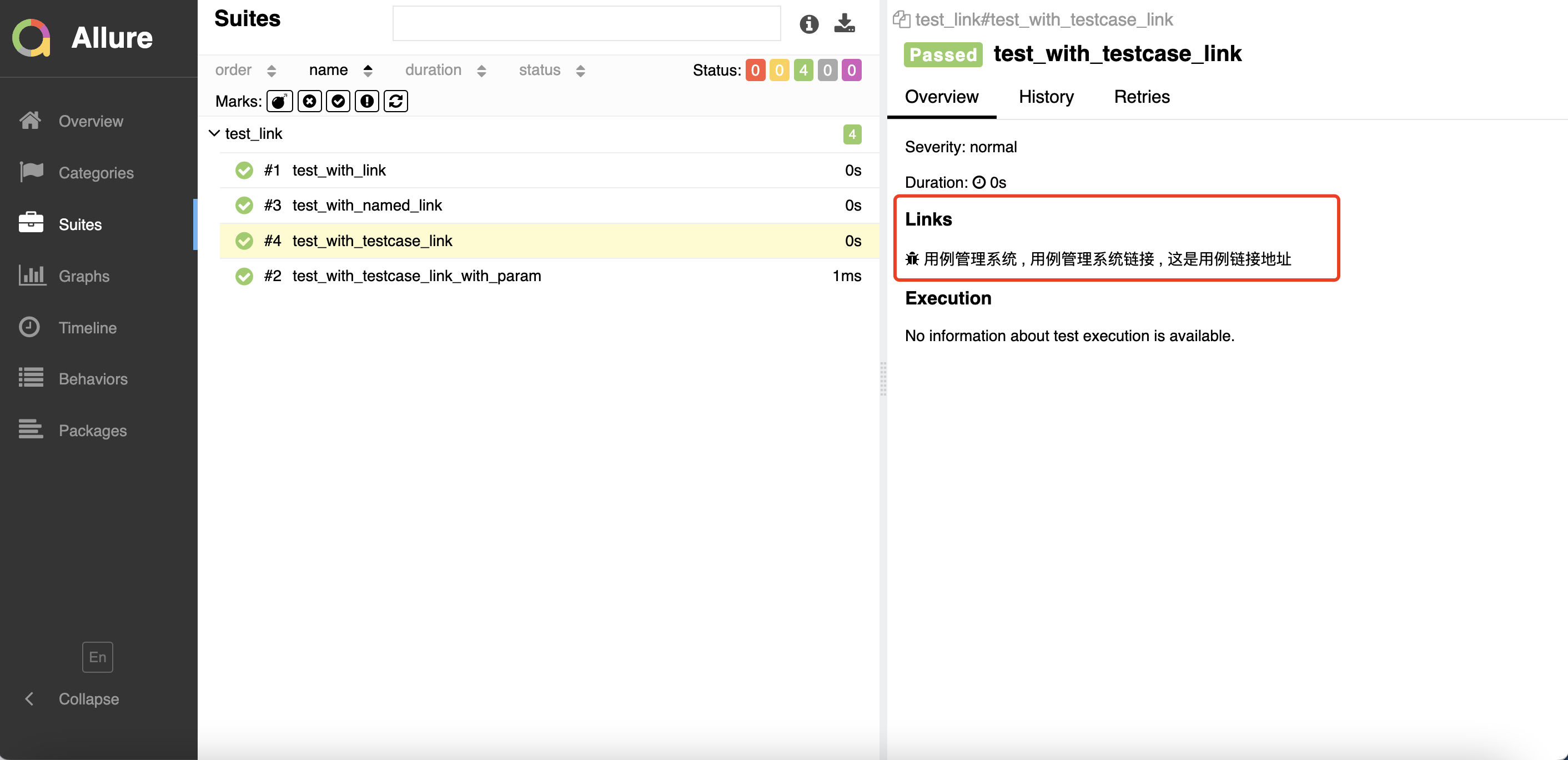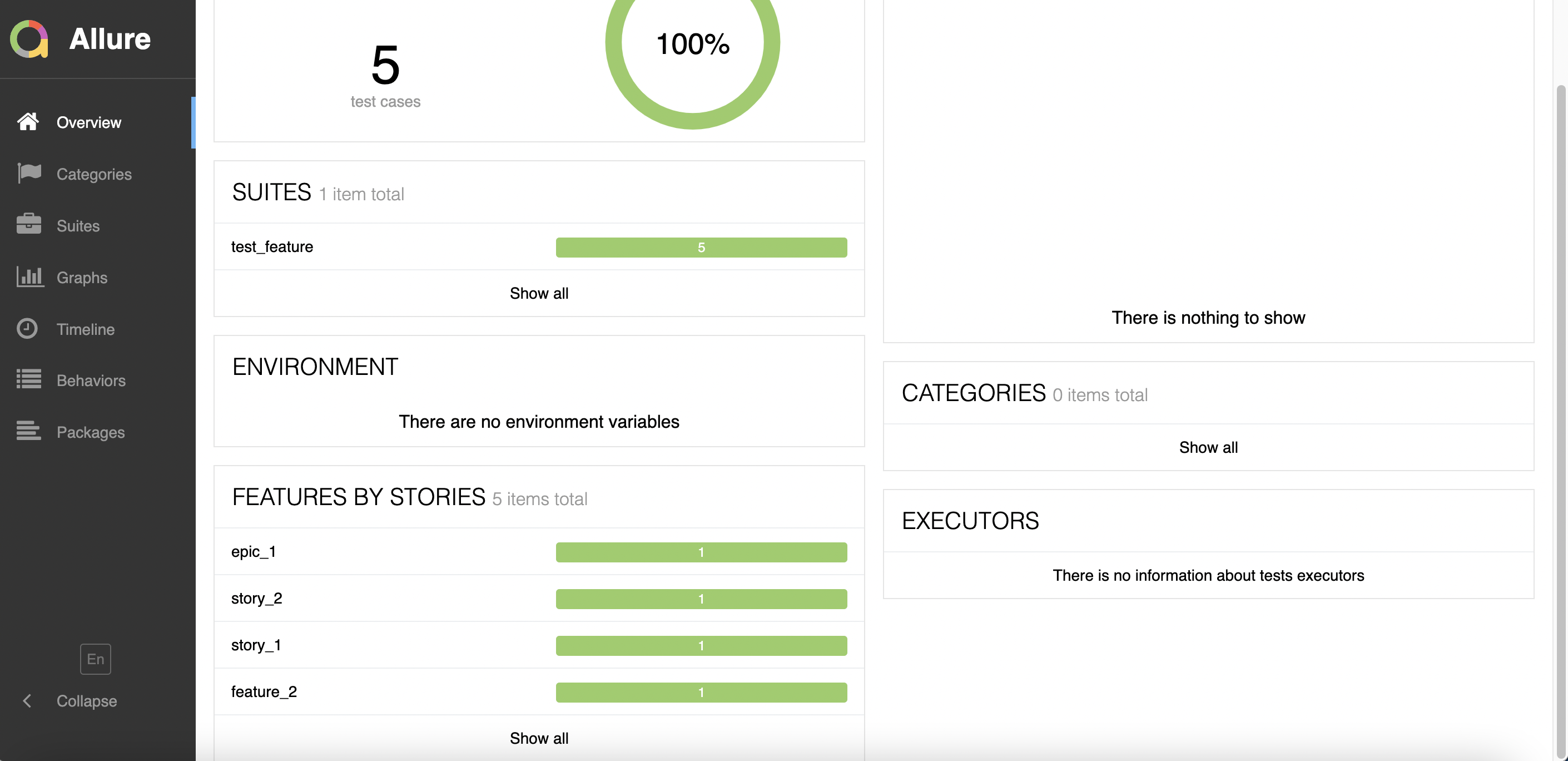1、Allure2报告中添加用例链接
Allure2 用例链接
应用场景:将报告与 bug 管理系统或测试用例管理系统集成,可以添加链接装饰器 @allure.link、@allure.issue 和@allure.testcase。

Allure2 用例链接
- 格式 1:
@allure.link(url, name)添加一个普通的 link 链接。 - 格式 2:
@allure.testcase(url, name)添加一个用例管理系统链接。 - 格式 3:
@allure.issue(url, name),添加 bug 管理系统链接。
# 格式1:添加一个普通的link 链接
@allure.link('https://ceshiren.com/t/topic/15860')
def test_with_link():
pass
# 格式1:添加一个普通的link 链接,添加链接名称
@allure.link('https://ceshiren.com/t/topic/15860', name='这是用例链接地址')
def test_with_named_link():
pass
# 格式2:添加用例管理系统链接
TEST_CASE_LINK = 'https://github.com/qameta/allure-integrations/issues/8#issuecomment-268313637'
@allure.testcase(TEST_CASE_LINK, '用例管理系统')
def test_with_testcase_link():
pass
# 格式3:添加bug管理系统链接
# 这个装饰器在展示的时候会带 bug 图标的链接。可以在运行时通过参数 `--allure-link-pattern` 指定一个模板链接,以便将其与提供的问题链接类型链接模板一起使用。执行命令需要指定模板链接:`--allure-link-pattern=issue:https://ceshiren.com/t/topic/{}`
@allure.issue("15860", 'bug管理系统')
def test_with_issue():
pass
2、Allure2报告中添加用例分类
Allure 分类
- 应用场景:可以为项目,以及项目下的不同模块对用例进行分类管理。也可以运行某个类别下的用例。
- 报告展示:类别会展示在测试报告的 Behaviors 栏目下。
- Allure 提供了三个装饰器:
-
@allure.epic:敏捷里面的概念,定义史诗,往下是 feature。 -
@allure.feature:功能点的描述,理解成模块往下是 story。 -
@allure.story:故事 story 是 feature 的子集。
-

Allure 分类 - epic
- 场景:希望在测试报告中看到用例所在的项目,需要用到 epic,相当于定义一个项目的需求,由于粒度比较大,在 epic 下面还要定义略小粒度的用户故事。
- 解决:
@allure.epic
"""
@Author: 霍格沃兹测试开发学社-西西
@Desc: 更多测试开发技术探讨,请访问:https://ceshiren.com/t/topic/15860
"""
import allure
@allure.epic("需求1")
class TestEpic:
def test_case1(self):
print("用例1")
def test_case2(self):
print("用例2")
def test_case3(self):
print("用例3")
Allure 分类 - feature/story
- 场景: 希望在报告中看到测试功能,子功能或场景。
- 解决:
@allure.Feature、@allure.story - 步骤:
- 功能上加
@allure.feature('功能名称') - 子功能上加
@allure.story('子功能名称')
- 功能上加
"""
@Author: 霍格沃兹测试开发学社-西西
@Desc: 更多测试开发技术探讨,请访问:https://ceshiren.com/t/topic/15860
"""
import allure
@allure.epic("需求1")
@allure.feature("功能模块1")
class TestEpic:
@allure.story("子功能1")
@allure.title("用例1")
def test_case1(self):
print("用例1")
@allure.story("子功能2")
@allure.title("用例2")
def test_case2(self):
print("用例2")
@allure.story("子功能2")
@allure.title("用例3")
def test_case3(self):
print("用例3")
@allure.story("子功能1")
@allure.title("用例4")
def test_case4(self):
print("用例4")
Allure 运行 feature/story
- allure 相关的命令查看 :
pytest --help|grep allure - 通过指定命令行参数,运行 epic/feature/story 相关的用例:
pytest 文件名 --allure-epics=EPICS_SET --allure-features=FEATURES_SET --allure-stories=STORIES_SET
# 只运行 epic 名为 "需求1" 的测试用例
pytest --alluredir ./results --clean-alluredir --allure-epics=需求1
# 只运行 feature 名为 "功能模块2" 的测试用例
pytest --alluredir ./results --clean-alluredir --allure-features=功能模块2
# 只运行 story 名为 "子功能1" 的测试用例
pytest --alluredir ./results --clean-alluredir --allure-stories=子功能1
# 运行 story 名为 "子功能1和子功能2" 的测试用例
pytest --alluredir ./results --clean-alluredir --allure-stories=子功能1,子功能2
# 运行 feature + story 的用例(取并集)
pytest --alluredir ./results --clean-alluredir --allure-features=功能模块1 --allure-stories=子功能1,子功能2
Allure epic/feature/story 的关系
- epic:敏捷里面的概念,用来定义史诗(需求,项目),相当于定义一个项目。
- feature:相当于一个功能模块,相当于 testsuite,可以管理很多个子分支 story。
- story:相当于对应这个功能或者模块下的不同场景,分支功能。
- epic 与 feature、feature 与 story 类似于父子关系。



